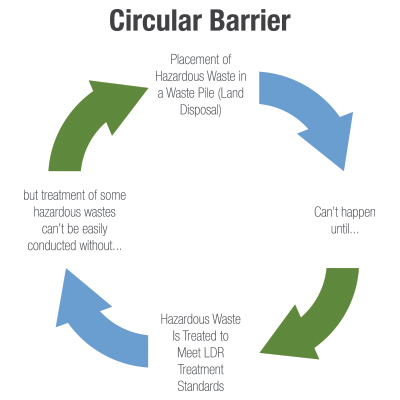
Prior to the EPA’s development of the concept of containment buildings in 1992 certain heavy or bulky hazardous wastes were a serious problem for generators. Because of the issues that these wastes posed, the EPA developed standards for a new waste management unit (containment buildings). A containment building is basically a structure in which solid hazardous wastes can be stored and managed without violating LDR. It is a fully enclosed structure (meaning it has at least 4 walls, a roof, and a floor) which houses an accumulation of noncontainerized waste.
Why did EPA need containment buildings?
Before the EPA decided that containment buildings (like tanks or containers) could serve as hazardous waste management units, a collection of noncontainerized waste within a roofed structure would have been considered an indoor waste pile and as such would have been subject to regulations and standards in Subpart L of 264/265.
Because some debris wastes are better suited to storage and treatment in waste piles as opposed to in tanks or containers it made more sense to treat them in such a way. Placement of untreated debris in piles prior to it being treated, however, violated LDR regulations in part 268.
The EPA provides the following example; “Under LDR, hazardous waste may not be placed on the land unless it meets certain standards that require treatment of the waste to reduce its hazardousness. Before land disposal, many wastes will be stored or treated to meet the LDR treatment standards in tanks and containers — units that are not considered ‘land disposal units.’ Managing hazardous waste in certain types of units, including landfills, surface impoundments, and waste piles, constitutes “land disposal,” which may not occur until the waste has been treated to meet LDR standards.
 Certain bulky hazardous wastes are not amenable to treatment in tanks or containers and must be treated in waste piles. Since the definition of “land disposal” includes placement of waste in a waste pile, doing so is prohibited unless the waste first meets all applicable treatment standards. Thus, to perform the treatment required before land disposal, the waste must first be land disposed. Under this scenario, the land disposal restrictions form a circular barrier to any management of certain hazardous wastes.”
Certain bulky hazardous wastes are not amenable to treatment in tanks or containers and must be treated in waste piles. Since the definition of “land disposal” includes placement of waste in a waste pile, doing so is prohibited unless the waste first meets all applicable treatment standards. Thus, to perform the treatment required before land disposal, the waste must first be land disposed. Under this scenario, the land disposal restrictions form a circular barrier to any management of certain hazardous wastes.”
What this all boils down to is that prior to the creation of containment buildings, there were some types of waste that were nearly impossible (or at least very difficult) to properly treat and dispose of. The idea behind containment buildings is that they break the aforementioned circular barrier and allow all hazardous waste to be handled properly.
The EPA made the decision to exclude containment buildings from the regulations imposed by LDR based on the belief that a totally closed off unit, designed in compliance with the regulations in Part 264/265 subpart DD, can provide an equal level of containment as tanks and containers. Ergo containment buildings joined the fold and can now house waste without violating LDR.
Keep checking the blog for more posts about containment buildings. So does your company utilize containment buildings? How have they helped your process? Let us know in the comments section!
All information for this blog post was gathered from the EPA document, “Introduction to Containment Buildings.” As always, this blog post is not intended to be comprehensive and it is always best to check with the EPA and local government for full, up-to-date, rules and regulations.







